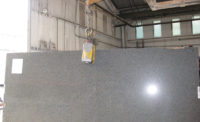The San Fernando Cathedral courtyard renovation, recently recognized in the stone and tile commercial category of an installation awards competition held by Floor Covering Installer, a sister publication of Stone World, features Mexican Cantera stone and slate. Erin Albrecht, owner J&R Tile in San Antonio, TX, the tile contractor for the project, shared some of the challenges and other details related to the job.
Challenges
In the heat of downtown San Antonio, TX, the renovation project included removal of an old flagstone patio and installation of 3/4-inch new stone with 1/16-inch grout joints. The job included many challenges. Working downtown in the city center of San Antonio -- the 8th largest city in the country -- it was difficult to coordinate materials and tools in the allotted timeframe.

J&R had to install over 8,000 square feet of a mortar bed prior to installation, and salt finished concrete radiuses meant that the stone installation would have to be cut at many radiuses. Due to an exterior renovation, special attention was needed for exterior movement joints every eight to 12 feet to the Tile Council of North America (TCNA) standards for exterior stone.


Two ramps for entering and exiting the courtyard also needed a slip-resistant treatment to make the area safe for tourists. J&R Tile partnered with Stonecare of Texas for this treatment to create a solution.

Unique Features
Surrounding the courtyard are custom 6-x12-inch engraved slate stone tiles that were installed after patrons of the Catholic Archdiocese purchased them. These included family and business names. Mortar beds had to be floated for each individual bay as more purchasers lined up. Custom fabricated Mexican Cantera stone surrounded the 6-x12-inch slate.
“One thing that I think really separates us from the competition is the ability and skills of our installers to do mud work,” said Albrecht. “This project was done in the heat of summer – 100-degree temperatures – in downtown concrete San Antonio. Logistics were particularly difficult. Getting the mud work dialed in was a significant challenge between it being a large project with the coordination and the intense heat. The heat caused the mortar to dry up quickly.” Albrecht explained to combat the heat they had to slightly adjust the water to sand ratio.
“Even though site conditions were difficult, we are really pleased with the final results.”






